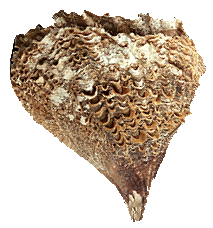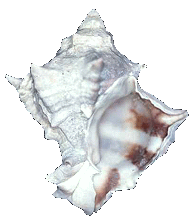|
Personal
Adornment
|
| It can
be said that every culture has used shells, whole or in part, and pearls
as personal adornment. Some cultures even wore shells as part of their elaborate
costume to signal their distinct tribal identities and to display their
role and rank within the tribe. In some parts of India, a Hindu woman's
equivalent of a wedding ring is a bracelet made of the sections of the Indian
(or Sacred) Chank. |
|
Some of the other
ways shells have been used as adornment are:
-
as shell
jewelry (pendants, earrings, finger rings, nose rings, bracelets,
etc.)
|
|
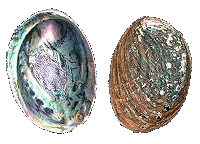 |
- as buttons
and fasteners Abalone shells (Haliotis), especially
the famous Paua shell (Haliotis iris Martyn)
from New Zealand, were once extremely popular for buttons
- until plastic took over!!

|
| The
freshwater mussels of the Mississippi river system were used extensively
to make "pearl buttons" for many years. According
to one source (Pennak) in the year 1912 there were 196 pearl button
factories in 20 states along the rivers of this great river system.
They sold over 6 million dollars worth of buttons that year. These
same mussels are today being used as the "seed" for cultured pearls.
|
-
As decoration
or as intrinsic parts of their function, shell or mother of pearl
(iridescent shell interior of many species of bivalves) were commonly
used on ceremonial or religious garbs.
-
As clothing
adornment, pearls are frequently sewn on as jewelry, fresh and
saltwater pearls are used in many ways as inserts in ceremonial masks.
-
A new page showing
many forms of shell use
-
Denatlium Purse.
These photos show a carved elk antler purse which was used by the
people of Hoopa Indians in California to carry their Dentalia shell
money. It was made and used by men.
|
|
2. as Dyes:
Dyes made from molluscs were used to beautify clothing and other items
made from cloth.
Depending on the species
of mollusc used, the final product varied from red to violet to almost
black. As early as the fifteenth century BC, the people of Tyre and Sidon
had found a way to extract the purple dye from some molluscs. The same
royal purple colour worn by kings, emperors and high priests in the
past is still used in the robes and alter mantles of some religions today
FONT-Note: The color the ancients
called "purple" (Royal or otherwise), was in fact closer to a dark burgundy
or maroon, and various shades of blue were also included under the general
moniker of Purple. In the northern Mediterranean, the dye-makers
found they could alter the color produced by urinating into the vat! (The
priests and nobles who wore the finished product probably never even knew!)).
An example of this
is The P'til Tekhelet (i.e., "Biblical
Blue"), the Association for the Promotion and Distribution Of Tekhelet
in Jerusalem, Israel. This society still uses and makes the Biblical blue
to produce the Jewish ritual fringes on their prayer shawls. In the Old
Testament, this blue was so rare and highly valued that it could be collected
only once every seventy years and was used to dye just one thread at each
corner of the prayer shawl.
Even though artificially
produced dyes are available at a fraction of the cost, many Mexican and
South American natives still prefer the molluscan dyes for their garbs,
since they produce more natural - looking and traditional hues.
In Oaxaca, the Mixtec still search the seashore for the pretty Purpura
patula pansa Gould, 1853) (the "Wide-mouthed Purpura"), squeeze some
of their juices onto yarns, and return the shell to its home, to be used
again the following season. These same dyes were used as early as 400
BC
Some
molluscs that have been used to dye material are:
|
- Murex miliaris Gmelin,
1791 (Syn: Vitularia miliaris) (Mediterranean)
Note: once known as M. purpura
Deshayes, 1834. This is a good example of a "synonym": when someone
gives a name to a species (i.e., "describes" it, in scientific lingo,
since the process involves publish a description of a single specimen
of the species, which becomes known as the "holotype" for that
species, or several specimens, which are then called "syntypes"
|
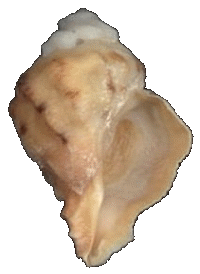 Murex miliaris
Murex miliaris
|
|
(Syn in Latin means
"together" - the specimens are used together, as a group, to represent
the species.) which someone else has already described before, the first
name has priority when other scientists discover that the two names have
been given to the same species. The second (and all other names
a species may accumulate - up to a hundred or more, for very variable
beasties!) then becomes a "synonym" of the first name, which is the only
one that is valid.
This can cause confusion at times, especially when a name has been used
for a long time before an older name is dug up, and everyone has to change
his or her labels! - But it is the only fair way of making sure the original
describer (known as an "author", since every new name for anything must
be published in an article in a scientific journal, or in a book) gets
the credit he or she deserves.
|
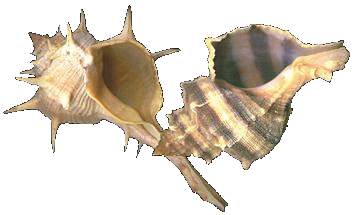
Murex brandaris and Murex trunculus |
- The Purple Dye
Murex (Murex brandaris L.- (Mediterranean):
Note: Linneus described (i.e., named) so many common species
that his name as an author (see above note) is often simply abbreviated
to "L.", for convenience!) - Uncounted millions of these Murexes
were killed to make purple dye for the Roman Empire!
|
- Hexaplex
trunculus (Linne, 1758): (right)
This shell was equally important with brandaris in the ancient purple
trade and it was most extensively used by the Phoenicians, but also
by the Romans and other Mediterranean cultures.
See: Ode To
Murex trunculus.
By Gilbert E. Brooke.
|
|
|
|
-
Certain
Rock Shells Thais haemastoma (L.), T.
clavigella (Kuster, 1856), and T. leucostoma (Gmelin, 1791)) (Europe)
|
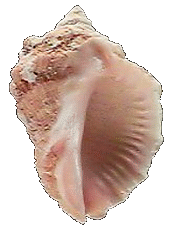
Thais haemastoma |
- The Atlantic Dog
whelk (or "Dog winkle"): (New England and Eastern Canada, and
also Europe).(Nucella lapillus (L.)) In Nova Scotia,
someone once tried to set up a factory to produce purple dye from this
species, but it flopped because it proved too labor-intensive to gather
and handle the millions of individual specimens involved: by the time
they paid all the workers, there was no money left for profits!
|

Nucella lapillus |
- The Purple-mouthed
Purpura:(Purpura patula pansa (Gould, 1853)).(Central
America) (see above article on dyes).
|
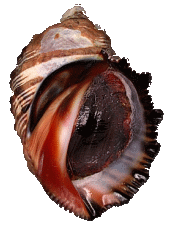 Purpura patula
pansa
Purpura patula
pansa |
| Note:
All of the above species belong to the Murex Family, and all produce a bluish-reddish-purplish
type of dye. |
|
|
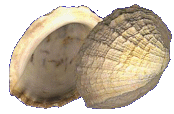 Concholepas concholepas
Concholepas concholepas
|



